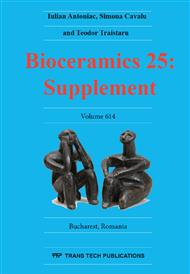p.168
p.173
p.178
p.183
p.190
p.196
p.200
p.206
p.212
Potential Solutions to Increase the Corrosion Resistance of Metallic Surgical Instruments Using Different Types of Ceramic Coatings
Abstract:
The overwhelming majority of medical instrumentation are executed form metalic materials, form the category of austenitic steinlees steel and titan alloys, which poses a good rezistance to corrosion, appropriate mechanical properties, and a good biocompatibility. The lifetime for the medical instrumentation is generaly low due to the modification of surface properties of metal tools from poor maintenance by medical personnel performing decontamination and sterilization operations (having no knowledge of material science), or the the improper use of chemical reagents or low quality of water used in decontamination processes. Identified solutions to improve surface properties of these parts of surgical instruments made of metallic consist of deposition of protective coatings. In this experimental study, we perform different coatings on a substrate made by stainless steel type 316L. We use different coating materials, each deposited by a specific method: hard ceramic biomaterials (TiO2 and YSZ - yttria stabilized zirconia) deposited by the method of deposition and plasma, respectively zirconium carbonitride (mono and multilayer) deposited by cathodic arc deposition method. The obtained coatings was analyzed using scanning electron microscopy coupled with EDS in order to characterize the morphology and composition of the coatings. The selected samples were tested for corrosion resistance. Corrosion resistance was determined by linear polarization technique, which involves plotting the potentiodynamic polarization curves of-1 V (vs. OC) to 1 V (vs SCE), with a scan rate of 0.5 mV / s. The corrosion tests was performed in physiological saline infusion (NaCl concentration 7%) at room temperature (25 ± 1 ° C) according to ASTM G15-97a. As a general conclusion we can say that layers ZrCN based presents the best parameter values of corrosion and therefore the best corrosion resistance in the case of surgical instruments.
Info:
Periodical:
Pages:
206-211
Citation:
Online since:
June 2014
Price:
Сopyright:
© 2014 Trans Tech Publications Ltd. All Rights Reserved
Share:
Citation:


